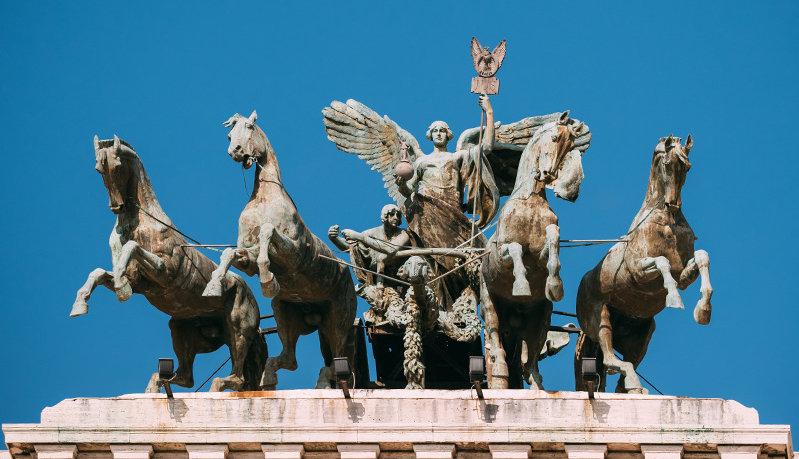

Published on: 04/18/2025
This news was posted by Fitness Fusion
Description

One of the problems that we face in reading the Bible is that we become so familiar with some passages and what they mean to us, that we no longer try to get to grips with what is really going on. In particular, we have a tendency to look at the Bible as if it were written today in a modern religious, cultural and political context. In doing so, we miss some of the symbolism and implications that would have been very clear to the original witnesses of the events.
We have a tendency to look at the Bible as if it were written today in a modern religious, cultural and political context.
The period which is bracketed between Jesus riding into Jerusalem on Palm Sunday and his crucifixion and resurrection a week later is referred to by some Christians as Holy Week. This is a period redolent with spiritual meaning and significance, but in Roman occupied Palestine there were other things going on that are less obvious to the twenty first century reader.
Palm Sunday
We are familiar with the events of Palm Sunday, where Jesus rode into Jerusalem on an ass with the crowds cheering him on and waving palm branches. It is one of the few events recorded in all four of the canonical Gospels. It is often referred to as Jesus triumphal entry into Jerusalem and this term gives us an important insight into some of the significance of the event.
A triumph was the highest honor awarded to a Roman general. Having fought a successful campaign overseas, a general might be given the privilege of parading through the streets of Rome with his legions and line upon line of vanquished people and slaves.
A triumph was a great holiday for the people of the city of Rome and a clear sign of which generals were rising in political influence. Triumphal parades were held across the empire whenever a city or region was captured or subdued, though these couldn’t compare with the huge events in Rome.
Triumphs were something that everyone in the Empire was aware of, they were a sign of who was in charge; a naked display of Roman power. Paul uses the image of a triumphal parade in his epistles:
And having disarmed the powers and authorities, he made a public spectacle of them, triumphing over them by the cross. (Colossians 2:15)
Here, Paul is referring to the way in which conquered people and rulers would be humiliated by being shown off in a parade. Another example of this sort of language is in a passage which is often badly misunderstood:
For the Lord himself will come down from heaven, with a loud command, with the voice of the archangel and with the trumpet call of God, and the dead in Christ will rise first. After that, we who are still alive and are left will be caught up together with them in the clouds to meet the Lord in the air. (1 Thessalonians 4:16, 17)
The key question in this verse is which direction is Jesus going in? Up or down? When conquering legions were entering Rome for a triumph, trumpeters would sound outside of the city and the people would flock out to meet the troops and accompany them back into the city cheering as they went. Here, we see Jesus returning to earth to rule as king and calling out his followers to accompany him on his triumph.
Triumphal parades were so well known that Paul could use them to illustrate points in his letters. In this context, it is clear that Jesus riding into Jerusalem, accompanied by cheering crowds is a deliberate and calculated imitation of the Roman tradition.
Yes, he was fulfilling prophecy, he was showing meekness and he did weep over the plight of Jerusalem, but he was also subverting the way in which the Roman Empire liked to show its strength and power to the world. We might miss the symbolism, but the people of the time did not.
The crucifixion
People who write about the Roman Empire or the early spread of Christianity often write about the pax Romana, the Roman peace. Across the Roman empire there was peace and security. Travelers, such as the Apostle Paul could cover vast distances in relative safety. It was a remarkable situation and one that was not to be repeated for hundreds of years. It’s no wonder that people write very enthusiastically about the pax.
The Romans were a brutal bunch.
However, there is a dark underside to the “peace” that people don’t talk so much about; the way in which it was imposed. For all of their supposed civilization, their central heating and fine oratory, the Romans were a brutal bunch. The empire existed on the back of dreadful slavery and through systematic violence. The pax Romana was maintained by brutally killing people who stepped out of line—often by crucifixion. The Roman peace was imposed by using the cross.
This is the background against which Paul wrote his letters and it demonstrates why I think that Colossians 1:20 (when read in context) is the strangest verse in the whole Bible.
… and through him to reconcile to himself all things, whether things on earth or things in heaven, by making peace through his blood, shed on the cross. (Colossians 1:20)
The Romans were quite used to the idea of making peace by shedding blood on the cross—they did it all the time. Only, their idea wasn’t to reconcile people, but to exterminate anyone who threatened the state. Paul however, takes this familiar concept and turns it completely on its head.
This one little verse... undermines the whole structure of the Roman empire.
Christ, the creator, the one who is greater than the emperor (as he sets out earlier in the chapter), is the one who died and through his death he brings reconciliation and real peace. This one little verse isn’t just a wonderful statement of Christian faith, it also undermines the whole structure of the Roman empire.
The cross, a brutal threat and a symbol of oppression is transformed by Christ’s death into a symbol of hope. The Roman empire achieved many great things, but it did so at an incalculable cost of human misery and suffering. Christ is bringing in his kingdom, which will be far more peaceful than Rome could ever have managed, but he is the one who suffered.
Again, Jesus did die to pay the penalty for our sins, he did conquer death and suffering, and he rose again in glory. All that is true, but the way he did so overturned conventional ways of thinking about power and significance.
Other events of Holy Week; overturning the money changers’ tables and washing his disciples feet underline this pattern further.
It is the resurrection which proves the validity of all that Jesus accomplished.
Of course, all of this subverting the imperial meta-narrative would mean nothing if Jesus just ended up in an unmarked grave somewhere in Palestine. It is the resurrection which proves the validity of all that Jesus accomplished. It ensures us that we will rise with him, that our forgiveness really has been earned, but it also demonstrates that the most powerful political force in the world could do its worst and Jesus could still, literally, rise above it.
The obscure Judean Rabbi on his donkey was more powerful than the greatest Roman general and the condemned criminal could turn the symbol of Roman brutality into a sign of God’s rule and grace.
Originally published on Dr Eddie Arthur's Living in the Venn Diagram Substack. Republished with permission.
Dr Eddie Arthur has been a member of Wycliffe Bible Translators for over thirty years. For twelve years he and his wife Sue lived in Ivory Coast where they were part of the team translating the scriptures for the Kouya people. He is now based in the UK where he researches, writes, and talks about the future of global missions and provides contextual perspectives on societal change. Eddie's more recent writing can be found on his Substack "Living in the Venn Diagram".
News Source : https://www.christiandaily.com/news/easter-time-reminds-us-of-what-power-has-always-looked-like
Other Related News
04/19/2025
We spend our lives waiting and it often isnt easy Sometimes the longer we wait the more un...
04/18/2025
By Ian M Giatti Christian Post Reporter Friday April 18 2025A screenshot of the Karmelo ...
04/18/2025
By Samantha Kamman Christian Post Reporter Friday April 18 2025Kerry Hasenbalg is a spea...
04/18/2025
By Morning Star News Friday April 18 2025Burial of Pastor Subhash Baghel on Jan 27 2025 ...
04/18/2025












